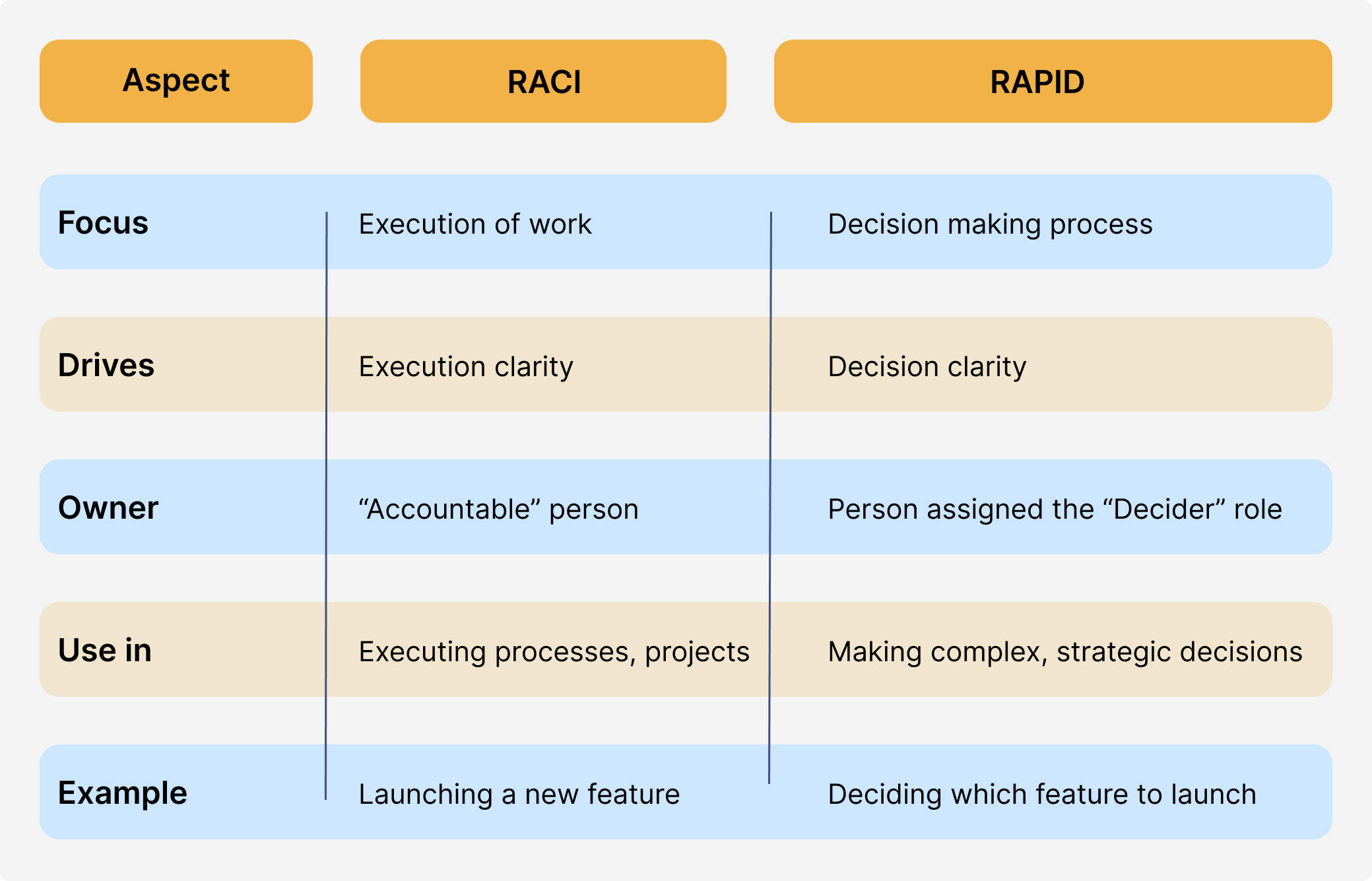
Introduction
For a Chief of Staff, one of the most persistent and costly bottlenecks is ambiguous decision making at the executive level. When accountability isn't clearly defined and the process of decision making is unstructured, critical initiatives stall, windows of opportunity close, and valuable time is squandered in circular conversations. The result is organizational drag and a frustrating sense of inertia. This isn't just an inconvenience, it's a significant competitive disadvantage. The core problem is rarely a lack of ideas or talent, but a lack of a clear, shared process for making and executing high-stakes choices.
The RAPID Framework
The RAPID framework, developed by Bain & Company, is a powerful tool to clarify accountability and assign specific roles to individuals in the decision making process. It is important to note that it is not a committee based consensus model. It helps in ensuring that the right people are involved at the right times and that decisions, once made, stick. It forces clarity by deconstructing a decision into five key roles, "Recommend", "Agree", "Perform", "Input", and "Decide".
Step 1 - Define the Decision and Assign the "D" (Decision)
Before any discussion begins, clearly articulate the specific decision that needs to be made. Is it "Should we enter the European market?" or "Which CRM software should we purchase?" Vague definitions lead to vague outcomes. Once defined, the single most important step is to assign the "D" (Decide). This person has the sole authority to commit the organization to action and resolve any impasse. This role should be assigned to the executive whose P&L or functional area is most impacted by the outcome. This single point of accountability immediately cuts through the noise.
Step 2 - Assign the "R" (Recommend)
The "R" (Recommend) role is assigned to the individual or group responsible for gathering the necessary data, conducting the analysis, and putting forth a clear, evidence-based recommendation. The Recommender drives the process. They must consult the right experts, weigh the alternatives, and present a compelling case to the "D". This is often the most labor intensive part of the process and typically falls to a CoS, strategy manager, or a functional expert.
Step 3 - Identify the "I" (Inputs)
The "I" (Input) role is for those whose expertise is valuable. Their contribution is in the form of expertise, know-how, experience and any relevant information to help shape the recommendation. Such inputs are ultimately at "R"s discretion to use.
Step 4 - Identify the "A" (Agree)
The "A" (Agree) role is given to individuals who must agree with the recommendation before it moves forward. Their agreement is a required sign-off, often for legal, compliance, or regulatory reasons. This role has veto powers and should be used carefully to avoid creating new bottlenecks. Make sure to clearly distinguish the “A” and “I” roles, and remember that only those with the “A” role should have to agree with the recommendation.
Step 5 - Designate the "P" (Perform)
Once the decision is made, someone must execute it. The "P" (Perform) role is assigned to the individual or team responsible for implementing the decision. It’s crucial to identify them early in the process, as they can provide valuable inputs on the practicalities and resource requirements of the proposed options. Involving the "P" ensures that the decision is grounded in operational reality.
Its not the same as RACI
It is easy to think of RAPID to be the same as RACI. However, they are very different and operate at entirely different levels of the organization. RACI is about execution discipline. It clarifies who is doing the work, who owns the outcome, who contributes insights, and who stays informed. It keeps operational accountability clean and prevents overlap or confusion in delivery.
RAPID, in contrast, is about decision velocity and governance. It defines how major decisions are shaped, challenged, and ultimately made. RAPID ensures that decisions don’t get trapped in consensus loops and that authority to decide is explicit rather than implied.

Illustrative Scenario: A B2B SaaS Company Decides on a Pricing Model Overhaul
A mid-sized B2B SaaS company is facing slowing growth and feedback that its pricing is too complex. The CEO wishes to establish a new pricing model and tasks the Chief of Staff with leading the effort. The CoS uses the RAPID framework.
R (Recommend): The CoS (Chief of Staff) is assigned the "R". She forms a small working group with members from finance and sales ops. They analyze churn data, run a competitive analysis, model three potential pricing structures, and interview key customers.
I (Input): The VP of Sales, VP of Product, VP of Marketing, and Head of Customer Success are designated as "I". They provide input on market positioning, potential customer reactions, and implementation challenges. The CoS must incorporate their feedback into the final recommendation.
A (Agree): The Chief Financial Officer (CFO) is the "A". Any new pricing model must meet specific gross margin targets and be auditable, so her sign-off is non-negotiable.
D (Decide): The CEO holds the "D". After the CoS presents the final recommendation, complete with the CFO's agreement and a summary of the input gathered, the CEO makes the final call.
P (Perform): The VP of Engineering and the Head of Sales Operations are assigned the "P". They will be responsible for the technical implementation on the website and billing system and for training the sales team on the new model.
By using RAPID, the company avoids endless debate. Roles are clear, the process is structured, and the final decision is made efficiently with all critical perspectives considered.
Closing Thoughts
Implementing a framework like RAPID moves your leadership team from a culture of indecision to clarity. It replaces ambiguity with clear accountability, ensuring that strategic choices are made thoughtfully. By clarifying who recommends, who agrees, who provides input, who performs, and ultimately, who decides, you remove the friction that paralyzes so many organizations.
The forward-looking challenge is not just implementing the framework for a single decision but embedding it as the default operating rhythm for all high-stakes choices. How will you introduce RAPID to your team and champion its adoption until it becomes muscle memory? The organizations that master this will be the ones that outpace their competitors tomorrow.
We believe every business, no matter the size, can achieve strategic clarity and impact when armed with the right tools. If that resonates with you, let’s talk about how we can make it happen. Book your call today.






.svg)
.svg)
